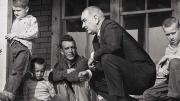In Invisible Americans: The Tragic Cost of Child Poverty (Knopf, $24), Jeff Madrick, M.B.A. ’71, an economics columnist, author, and teacher, draws attention to a problem Americans seem, mostly, inclined to ignore. At a time of intense debate about income inequality, he puts a face—or millions of young faces—on the meaning of real poverty and deprivation. Madrick begins by recalling Michael Harrington’s 1962 book, The Other America, and the federal government’s response, observing:
Harrington presented persuasive evidence that at least 25 percent of Americans were poor, and it shocked a nation that thought of itself as newly affluent. A middle class was flourishing by the 1960s. Harrington’s book and the buoyant economy combined to raise the American people’s sense of obligation and commitment to decency. Under President Lyndon Johnson, the country adopted a range of generous programs for the poor, including children, and people of color. This “War on Poverty,” though hardly as bold as it could have been, succeeded far more than its later deriders claimed.
But the child poverty rate in America today is 20 to 25 percent as I measure it, and arguably higher, and it has produced no wave of response vaguely similar to Johnson’s more than 50 years ago. My purposes here are to document the scourge of child poverty, the many ways it damages children and limits their possibilities, to make clear the immense irresponsibility of the world’s richest nation to tolerate basically the highest child poverty rates in the developed world, and to recommend what should be done about it.
There are roughly 13 million officially poor children in America, nearly one in five. If properly measured it would be closer to one in four, and with more honest assumptions more than one in three. In France and Germany only around one in 10 children are poor, and by a more stringent test. In the Nordic nations, only one in 30 children are poor. Child poverty is lower in these nations not because the economy produces fewer poor people but because social policies are directed at supporting the poor more generously and efficiently than in the United States.
Our struggling children lack material goods and services, including minimally decent shelter and healthcare. The level of material deprivation, or hardship, as analysts call it, is much higher than the government-reported poverty rate.…
I will argue that poor children have many requirements, but above all they need money.









